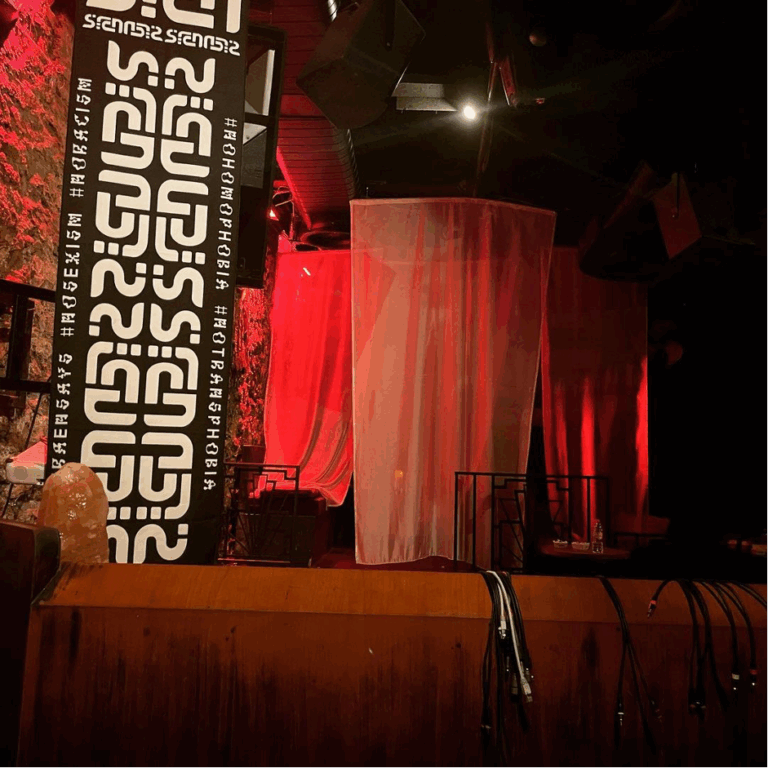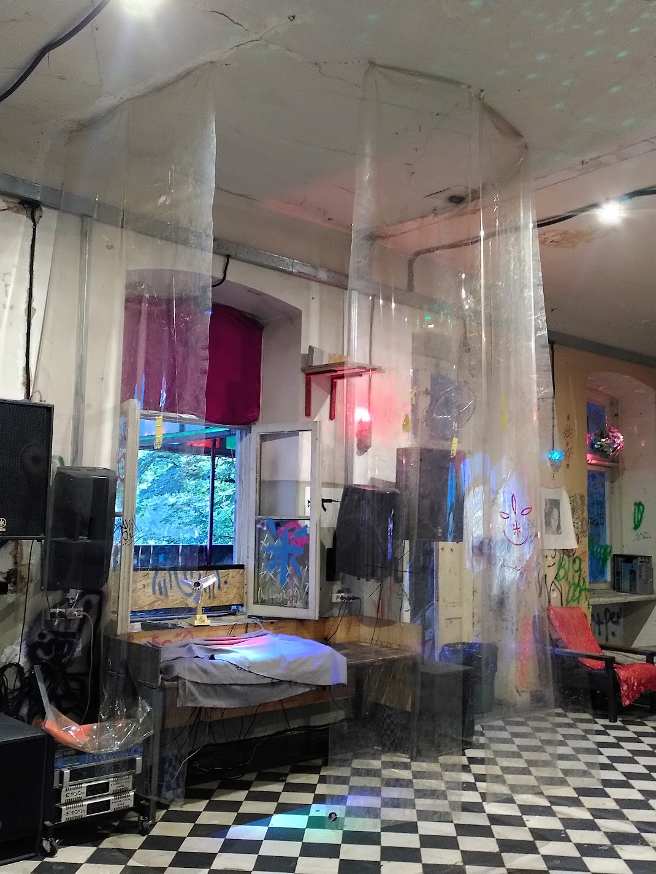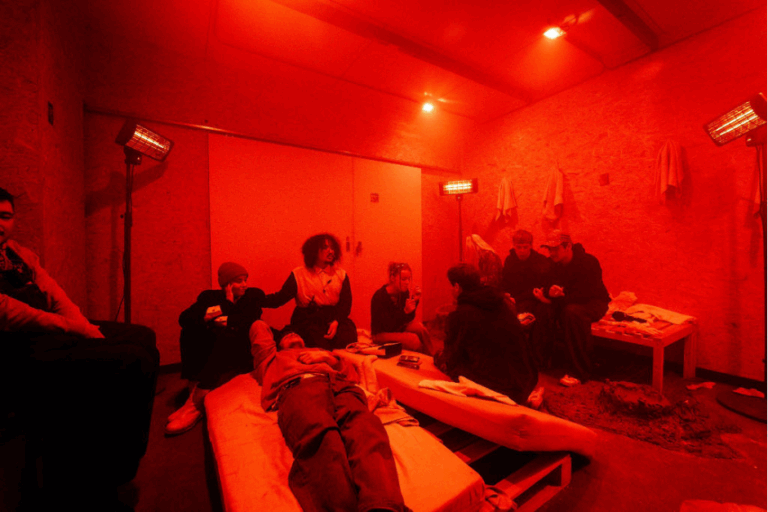Authors: Adèle Meunier and Axel Simon
If clubs are spaces where it's possible to escape the daily grind, to express oneself freely, or to shelter communities, they still sometimes remain environments that aren't entirely safe for audiences and artists. A case in point is the harassment suffered by Paloma Colombe at the Cabaret Sauvage in Paris in September 2023, in a DJ booth surrounded by the public, where no one came to her aid for two hours. In addition to raising awareness of safety issues in clubs and implementing concrete safety measures and charters, measures relating to the spatial, lighting, auditory, and sensory environment of clubs, as well as the way dance floors and DJ booths are organised, are also part of the solution.

© Sirän
Who Designs Club Spaces?
Sarah Gamrani and Hewan Aman, co-founders of the collective Au-delà du Club, begin by asking: “What are the intentions of people who think about club spaces?”
For them, creating safer clubs and safer spaces in clubs must first be thought through by the people who design the clubs, by “de-centering themselves, thinking about all the bodies that come, all the identities that occupy the space, but also all the possible uses.”
Club Derive, a collective of spatial designers based in Brussels, clearly recognises the opportunities they have to shape and influence behaviour through spatial design. As a result, they take responsibility for creating environments that promote safety and care. One way they do this is by inviting the venue team, the bar staff, the DJ, the lighting engineer, the toilet attendant, and other stage designers to co-create the party environment.
That’s what the team at Tbili Orgia, a club in Tbilisi, are doing. Two of the club's founders, Vazha Marr and Luka Nakashidze, explain that they give artists the freedom to shape the party space as they see fit and to make their own contributions, even in an experimental way.
This co-ownership of the party, given to the people involved in its creation and development, leads them to be more respectful of the party space and therefore of the other people present in it.

© Tbili Orgia
Diversifying Club Spaces and Uses
It is not easy for club-goers to make the club party their own, because so many clubs operate on a closed, consumerist model.
For Au delà du club, the creation of multiple spaces within the club, with different uses and different temporalities, is fundamental to being there to party, but also to opening up more possibilities than moving between the dance floor and the bar. This can help take people out of the rush to party and make them more attentive to others. Au delà du club stresses the importance of clearly marking different areas with different, contrasting materials, for example, colourful and soft for a chill-out area in contrast to a dark and rough dance floor. They also point out that the bar should be conceived as a space for sharing and meeting, rather than a space for consumption, by keeping the sound level lower than on the dance floor, and creating spaces and furnishings that encourage meetings and discussions.
Club Derive shares this quest to create non-commodified uses of space to open up or encourage new, safer, festive behaviours. To this end, they create transformative spaces, where people can jump, dance, or climb on platforms, move objects like furniture, modify them, and eventually destroy them. For them: “If everything is finished, there's no room for flexibility. If it's unfinished and not too clean, then there's room for interpretation and personal freedom to interact, adapt, and appropriate.”
Spatial design is also a way for a community to make a space their own, and create a sense of security for its members within that space. This is the case of the Sirän collective, based between Istanbul and Berlin, which organises queer parties at the Suma club in Istanbul. In order to make this commercial club their own, Sirän hangs large banners with the collective's logo printed on them, along with what they stand for.
Yeşim Unan, one of the co-founders, also explains the importance of opening up spaces and encouraging free movement within them. The back of the DJ booth, which is usually a VIP area, then becomes a space accessible to everyone.
Making Dance Floors and DJ Booths Safer
As the main space in the club, where safety issues are most acute, the dance floor is the place where Au-delà du Club believes it's important to first break the one-way relationship between the audience and the DJ, and get people interacting with each other. One way of doing this is to place speakers around the dance floor, creating a kind of dance circle with people in the middle, as they do at Blitz Club in Munich.
Another way is to put the DJ booth in the middle of the dance floor. That way, people can see each other from both sides, creating a better sense of community.
Tbili Orgia is a great example of this, with the DJ booth in the middle of the club, spanning two rooms. The front of the booth is a window overlooking a more classic dance floor, and the back is like an open backstage, where you can relax while enjoying good sound quality and a view of the dance floor and the DJ.
However, the central position of the booth can sometimes mean that the boundaries between the DJ and the audience are overstepped, which calls for protective measures.
Au-delà du club suggests installing barriers around the booth that can be easily opened and closed by the DJ. At the Machine du Moulin Rouge in Paris, Anaco, another member of the collective, had a safety button installed on the booth so that club staff could intervene quickly in the event of harassment.
The Tbili Orgia team found an original way to make the DJ booth both safer and more accessible: it is surrounded by transparent PVC curtains, creating a physical separation from the audience, while giving the impression of being close to the artists.

© Club Derive
Dedicated Lower Intensities Safer Spaces
Clubs are places where the senses are particularly stimulated by light and sound. This stimulation can sometimes be too much for some people, both the audience and the DJs, and not conducive to a safe atmosphere.
Hewan of Au delà du club points out that when the sound is too loud, the need to shout to be heard–whether in the audience, in the DJ booth, or backstage–puts everyone on alert, the opposite of feeling safe. Creating places where it's easy to hear each other means good acoustic management of the club, for example with wooden floors, acoustic panels, curtains, or directional speakers–as at OHM Club in Berlin.
Overbearing or distracting lighting, such as strobe lights, can also cause problems, whereas good management of light intensity and colour can help create a warm, welcoming, and inclusive atmosphere. This is the case at Sirän parties, where red, subdued, and indirect light is installed in lanterns.
Club Derive has tested several solutions to vary the level of stimulation in clubs, giving people the choice to be stimulated in the way they want. For instance, creating sound walls to form spaces where it's easy to interact without leaving the dance floor.
Or by offering spaces away from the dance floor where the senses are less engaged. They once created a fake sauna as their own safe space where people could calm down and relax, with soft music, indirect, and subdued lighting, comfortable seating, and a relatively warm temperature.
For Au-delà du Club, these chill-out spaces need to be far enough away from the dance floor to create a first airlock. This intermediate level of stimulation avoids rapid transitions between the potential intensity of the dance floor and the tranquillity of the chill-out areas.
Even if the notion of safety can be different, especially in relation to the situation of safety, each experiment for their communities in the cities where they live. The combination of these different points of view contributes to the ongoing reflection on how to make clubs safer by rethinking their scenography. And while concrete changes are gradually taking place in clubs, there's still a lot to explore.
Published on July 8th, 2025
About the authors:
Adèle Meunier is a set designer and producer based in Paris and part of Avoir studio. She conducts research into the relationship between safe spaces and scenography, particularly in festive spaces.
Axel Simon is a stage designer and architect based in Paris and part of Hypnos Studio. He conducts research on nightclub environments design and regularly publishes articles in various media about it.